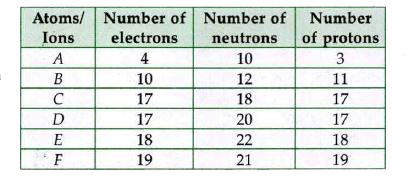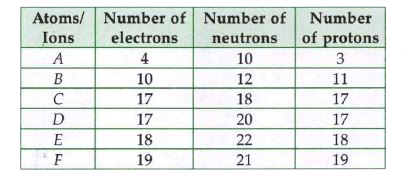The following data repersents the distribution of electons protons and neutrons in atoms of four element AltBltCltD

Answer the following questions:
(a)Describe the electronic distrubution in atom of element B. , (b) Is elements B a metal or a non metal? why ?
(c ) which two elements form a pair of isotopes? ,(d) which two element form in pair of iosbars?
(a) The electronic distribution of element B is 2,8,7
(b) The element B is non metal (CI) .Its atom needs only one electron to have the configuration of nearest noble gas element argon (2,8,8)
(c ) The elements B and C form pair of isotopes since both of them have same number of electrons 17 and also same stomic number (Z=17)
(d) The elements A and D represent pari of isobars since both of them have same number (a=40)
Topper's Solved these Questions
- STRUCTURE OF ATOM BOOK - DINESH PUBLICATIONCHAPTER - STRUCTURE OF ATOM EXERCISE - Higher order thinking skilll based questions
5 Videos
- STRUCTURE OF ATOM BOOK - DINESH PUBLICATIONCHAPTER - STRUCTURE OF ATOM EXERCISE - Multiple choice question
26 Videos
- STRUCTURE OF ATOM BOOK - DINESH PUBLICATIONCHAPTER - STRUCTURE OF ATOM EXERCISE - Short Answer Question
45 Videos
- MATTER IN OUR SURROUNDINGS BOOK - DINESH PUBLICATIONCHAPTER - MATTER IN OUR SURROUNDINGS EXERCISE - (LAQs) Long Answer Questions
5 Videos
Similar Questions
The electronic configuration of four elements A, B, C and D are:
View SolutionThe following table shows the position of six elements A, B, C, D, E and F in the period table.

Using the above table answer the following questions :
(a) Which element will form only covalent compounds ?
(b) Which element is a metal with valency 2 ?
(c) Which element is a non-metal with valency of 3 ?
(d) Out of D and E, which one has more atomic radius and why?
(e) Write a common name for the family of elements C and F.
View Solution
Knowledge Check
Which of the following elements does not form isotopes?
ACarbonBNeonCChlorineDIodineThe number of electrons in the atom of an element X is 18 and the number of neutrons is 22. Which of the following is the correct representation of an atom of this element?
A4019XB2218XC4022XD4018XThe number of electrons in the atom of an element X is 15 and the number of neutrons is 16. Which of the following is the correct representation of an atom of this element ?
A3115XB3116XC1615XD1516X
(i) Element X has two valence electrons in M-shell .
(ii) In element Y, the electrons are distributed in the first three shells. It has eight electrons in M-shell .
(iii) Element Z has eight electrons in the penultimate shell that is M.
Based on the information given in the above three statements, answer the following questions.
(a) Give the electronic configuration of X.
(b) Which element is stable among X, Y and Z and why ?
(c) In which atom of an element is the number of electrons distributed in all four shells ?
(d) What is the atomic number of Z in which the number of electrons in the first and the last shell are not the same ?
What are the number of electrons and protons present in 'Y' ?
View SolutionThe following table shows the position of six elements A, B, C, D, E and F in the Periodic Table.

Using the above table answer the following questions: (a) Which element will form only covalent compounds? (b) Which element is a metal with valency 2? (c) Which element is a non-metal with valency 3? (d) Write a common name for the family of elements C and F. (e) Out of D and E, which one has a bigger atomic radius and why?
View SolutionFour elements P, Q, R and S have atomic numbers 12, 13, 14 and 15 respectively. Answer the following questions giving reasons :
(i) What is the valency of element Q ? (ii) Classify these elements as metals and non-metals.
(iii) Which of the elements will form the most basic oxide ?
View SolutionElements from A to F have in them the distribution of electrons, neutrons and protons as follows:

Making use of these data, find
a pair of isotopes.
View SolutionElements from A to F have in them the distribution of electrons, neutrons and protons as follows:

Making use of these data, find
a pair of ions
View Solution
